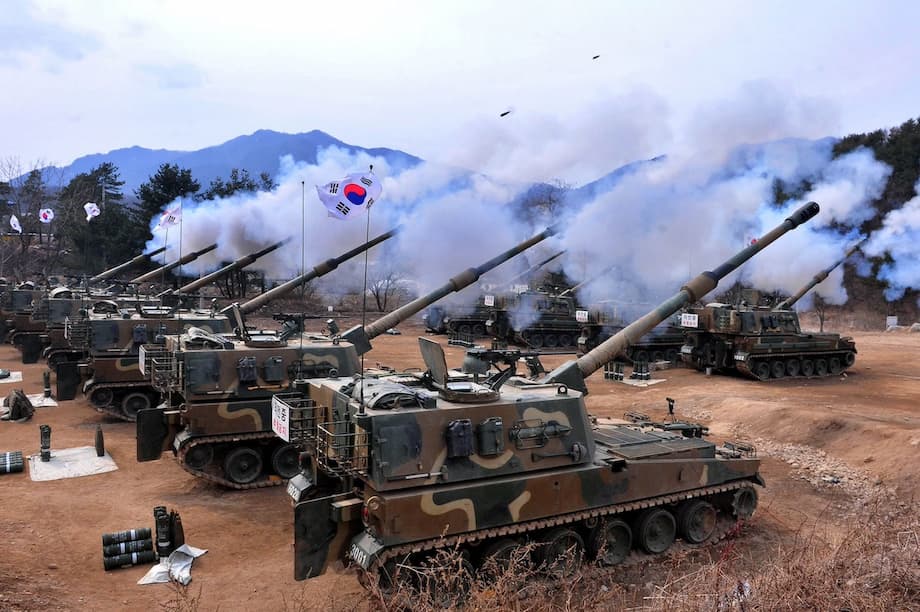Why Vietnam’s K9 purchase matters now
South Korea has crossed a threshold in Southeast Asia. Hanwha Aerospace will deliver 20 K9 self propelled howitzers to Vietnam under a government to government arrangement valued around 250 million dollars. The agreement, announced in August 2025, is South Korea’s first commercial arms sale to Vietnam and the first K9 sale in Southeast Asia. Deliveries are slated to finish by late 2025, with the Korea Trade Investment Promotion Agency (KOTRA) coordinating the export on the government side, according to multiple defense outlets. Reports from August indicate a 250 million dollar package, while earlier estimates in the first half of 2025 ranged between 245 million and 300 million dollars. The core contours are consistent across sources: twenty guns, training, and support, delivered quickly under state oversight.
For Vietnam, the purchase begins the replacement of a diverse mix of Soviet and US era artillery that lags behind modern systems. For South Korea, the contract shows that K Defense can compete in a market long supplied by Russian and Western manufacturers. Pricing near 12 million dollars per gun and rapid delivery timelines helped the K9 stand out. The howitzer is also proven. It serves in India, Australia, Poland, Finland, Norway, Estonia, Romania, Egypt, Turkiye, and South Korea itself. With Vietnam, it becomes the 11th operator of the system, according to defense trade reporting from Seoul and international outlets. Several analyses suggest this is the first export of South Korean weapons to a communist country, underscoring how unusual the deal is in political terms.
The war in Ukraine put artillery back at the center of modern land warfare. Armies that can move, shoot, and sustain long range fire are advantaged in a protracted campaign. Vietnam’s decision aligns with that lesson. The K9 offers fast shoot and scoot tactics, a digital fire control suite, and compatibility with widely available 155 millimeter ammunition. In a region where budgets are tight and delivery speed matters, the system’s record for cost, performance, and logistics has made it a leading choice.
A contract years in the making
The deal is the product of steady engagement. In March 2023, Vietnam’s defense minister visited South Korea and observed a K9 demonstration. By November 2024, a team from the Vietnam People’s Army trained in South Korea on K9 operation and maintenance. Hanoi’s interest was formalized again in April 2024 during a defense policy dialogue in Hanoi, where senior Vietnamese and South Korean officials discussed defense industry cooperation and logistics. Vietnamese artillery leaders later signaled that a future K9 unit could be assigned to Artillery Brigade 204 near Hanoi. After further training in mid 2025, the two governments finalized the purchase and made the announcement in August.
Several outlets report that delivery will be managed through KOTRA, a state agency that can broker government to government exports, rather than through a direct commercial sale alone. That structure signals the political weight both capitals attach to the transaction. It also suggests the package includes training, spares, and possibly the K10 ammunition resupply vehicle, an automated support platform that reduces reload time and improves sustainability in the field. Earlier reports carried higher figures near 276 million or 300 million dollars, likely reflecting preliminary options or currency assumptions, while the August confirmation centered on about 250 million dollars. Either way, the shape and scale point to a pilot buy that can be expanded if Hanoi is satisfied with performance.
What the K9 brings to Vietnam’s artillery
The K9 is a tracked, 155 millimeter, 52 caliber self propelled howitzer designed for high tempo operations. Most export users field the K9A1 variant, which features an improved fire control system and crew comforts that aid sustained operations in tough climates. Unit price often clusters around 12 million dollars without large support packages. For many armies, the calculus is straightforward. The K9 delivers near top tier performance at a price point and delivery pace that heavier competitors struggle to match.
Firepower and mobility
The howitzer can fire standard high explosive rounds to approximately 40 kilometers and specialized projectiles, including rocket assisted and guided types, to around 50 kilometers. A digital fire control system enables quick set up, rapid fire missions, and multiple round simultaneous impact, a tactic that sends several shells along different trajectories so they land together. Tracked mobility lets the K9 keep up with mechanized formations, while armor protection helps the crew survive counter battery fire and battlefield fragments. The system is operated by a five person crew and can reach road speeds near 67 kilometers per hour with an operating range reported around 360 kilometers. In practice, that means a battery can displace quickly after firing, complicating enemy targeting.
From mixed calibers to a 155 mm standard
Vietnam’s artillery units have long managed an eclectic inventory. Legacy pieces include 105 millimeter and 155 millimeter US era towed guns and 152 millimeter Soviet designs. Multiple calibers create a burden in training, maintenance, and ammunition supply. Moving a portion of the force to a 155 millimeter standard aligns Vietnam with the most common global supply chain for heavy artillery. That standardization simplifies procurement over time and creates more options for precision and extended range munitions sourced from a broader set of partners. It also eases cooperation in training and doctrine development with countries that already field the K9.
Training, sustainment, and possible add ons
Vietnamese personnel trained in South Korea in late 2024 and again in mid 2025, a sign that Hanoi wants crews and maintainers ready as deliveries begin. KOTRA’s coordination role points to a package that likely includes spares, tools, and technical assistance. Several media reports noted the possibility of adding K10 ammunition vehicles, which carry 155 millimeter rounds and charges and can reload a K9 under armor in minutes. That pairing turns each howitzer into a more persistent fire unit with faster turnaround between salvos. Analysts in South Korea noted that the first battalion sized set might be tasked to strategic units near Hanoi, consistent with comments from Vietnamese artillery leadership.
Why South Korea is targeting Southeast Asia
Seoul has made defense exports a pillar of its growth strategy. The government has spoken about reaching the top tier of global arms suppliers by 2027. A 2025 review put South Korea around 10th in global arms exports by value. After a surge of orders in 2022, year on year totals have softened as several large deals faced financing delays and political turbulence. Even so, the state has kept defense exports at the center of industrial policy, and the K9 sale to Vietnam is the clearest evidence in 2025 that K Defense remains on the front foot.
South Korea’s pitch in Southeast Asia combines performance, price, and speed. It also highlights a proven track record of meeting schedules, as seen in large artillery and tank packages for European customers. The K9’s success is part of a broader catalog that includes training aircraft and light fighters now flying with several Asian air forces. Southeast Asia has long been a region where Russian systems are common and Western kit is expensive or slow to arrive. South Korean systems fill a gap. They are modern, deliverable within months or a few years, and are backed by a state that can create financing and industrial partnerships. Several analysts have suggested that after this sale, a regional maintenance and support hub could follow, which would reduce downtime and operating costs for any new Southeast Asian customers.
A careful Vietnamese pivot away from Russia
Data from international arms transfer trackers show that between 2000 and 2023, roughly 80 percent of Vietnam’s imported weapons came from Russia. Several factors are pushing a shift. Sanctions and war related constraints have complicated Russian production and delivery. Spare parts flows are less reliable. Many of Vietnam’s older systems are approaching the end of their useful lives. Hanoi is also executing a long running strategy of diversifying suppliers so it is not reliant on any single partner. The K9 fits that logic. It is a stand alone system that does not require deep integration with alliance networks, yet it brings modern range, accuracy, and protection.
Vietnam’s security policy stresses independence and balance. The country has built ties with a range of partners while avoiding formal alliances. Buying a major land platform from South Korea fits comfortably within that approach. It broadens access to training and technology without tying Hanoi to a single superpower. The choice also hedges against uncertainty in Russian support while keeping options open with the United States, Europe, India, and Japan. In this context, the K9 buy is about resilience and choice as much as it is about firepower.
Regional ripple effects
Neighboring militaries will watch the K9’s performance in Vietnamese service. Several Southeast Asian armies still depend heavily on towed artillery, which is cheaper to buy but slower to move and more vulnerable to counter battery fire. A tracked system that can fire, move, and survive offers a different model of land power. Some states already field modern 155 millimeter guns, though not always in self propelled form. Others have looked at domestic assembly or technology transfer arrangements to stretch budgets and build local skills. South Korea’s willingness to discuss industrial cooperation and to deliver quickly makes its offer competitive across these scenarios.
The K9’s global base of operators, from India to Poland and Australia, also matters. Shared training syllabi, common spares, and a deep market for ammunition are powerful advantages for smaller militaries. If Vietnam opts for a larger follow up order after this initial batch, the presence of a maintenance enterprise inside the region would lower life cycle costs. That, in turn, could make a purchase more appealing for neighbors that prefer to evaluate systems that are already working with nearby armies.
Delivery, maintenance, and industrial cooperation
The export is unusual in its structure. Government coordination through KOTRA gives the deal a high level umbrella, while Hanwha Aerospace executes production and delivery. Several media reports indicate all 20 guns will arrive by late 2025. That timeline implies that training, spare parts provisioning, and initial stockpiles of ammunition will have to move in parallel. Vietnamese crews started this glide path in 2024 and 2025 with training in South Korea, which should reduce the time between delivery and operational fielding.
The two governments have also signaled broader defense cooperation. After a senior visit by Vietnam’s leadership to Seoul, the countries agreed to restart a bilateral defense and military cooperation committee that had been inactive for many years. The two sides also discussed deeper industrial links and a target to expand trade considerably by 2030. If the K9 performs as expected and sustainment proves reliable, follow on buys could include additional batteries, K10 ammunition vehicles, and expanded maintenance infrastructure. Several Korean outlets have suggested that the K9 deal can serve as a template for future government to government packages in the region.
Key Points
- Vietnam will receive 20 K9 self propelled howitzers from South Korea under a government to government deal announced in August 2025.
- The package is widely reported around 250 million dollars, with earlier estimates between 245 million and 300 million dollars reflecting evolving options and exchange rates.
- Delivery is expected by late 2025 and coordinated through the Korea Trade Investment Promotion Agency (KOTRA).
- Vietnam becomes the 11th operator of the K9, joining users such as India, Australia, Poland, Finland, Norway, Estonia, Romania, Egypt, Turkiye, and South Korea.
- The purchase starts a shift toward the 155 millimeter standard and replaces aging Soviet and US era guns.
- Training began in 2024, continued in 2025, and the package may include K10 ammunition vehicles for faster reload and higher readiness.
- Seoul views Southeast Asia as a priority market for K Defense, with potential for a regional maintenance hub if more customers follow.
- The deal reflects Vietnam’s broader strategy to diversify away from Russia while keeping a balanced, independent security posture.




